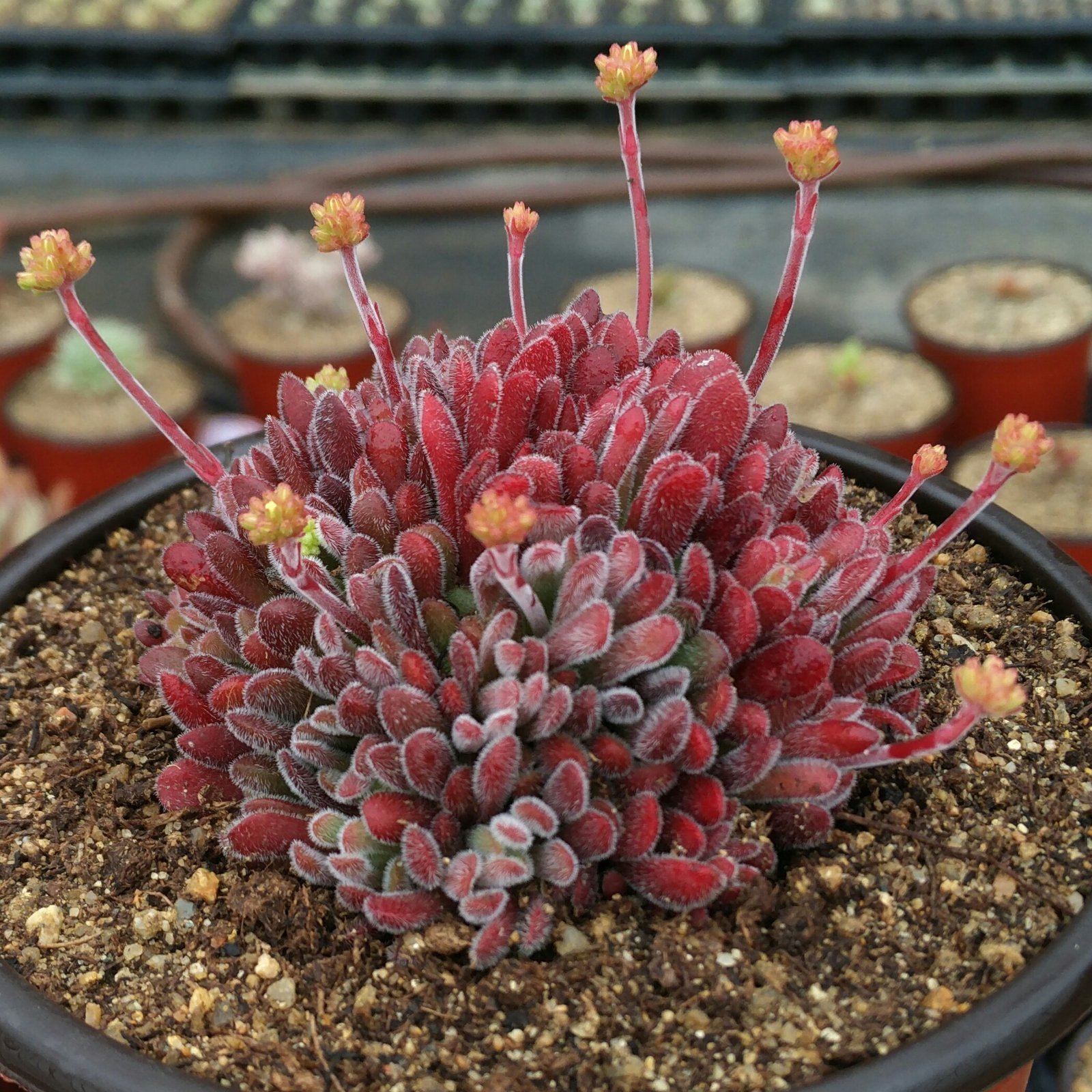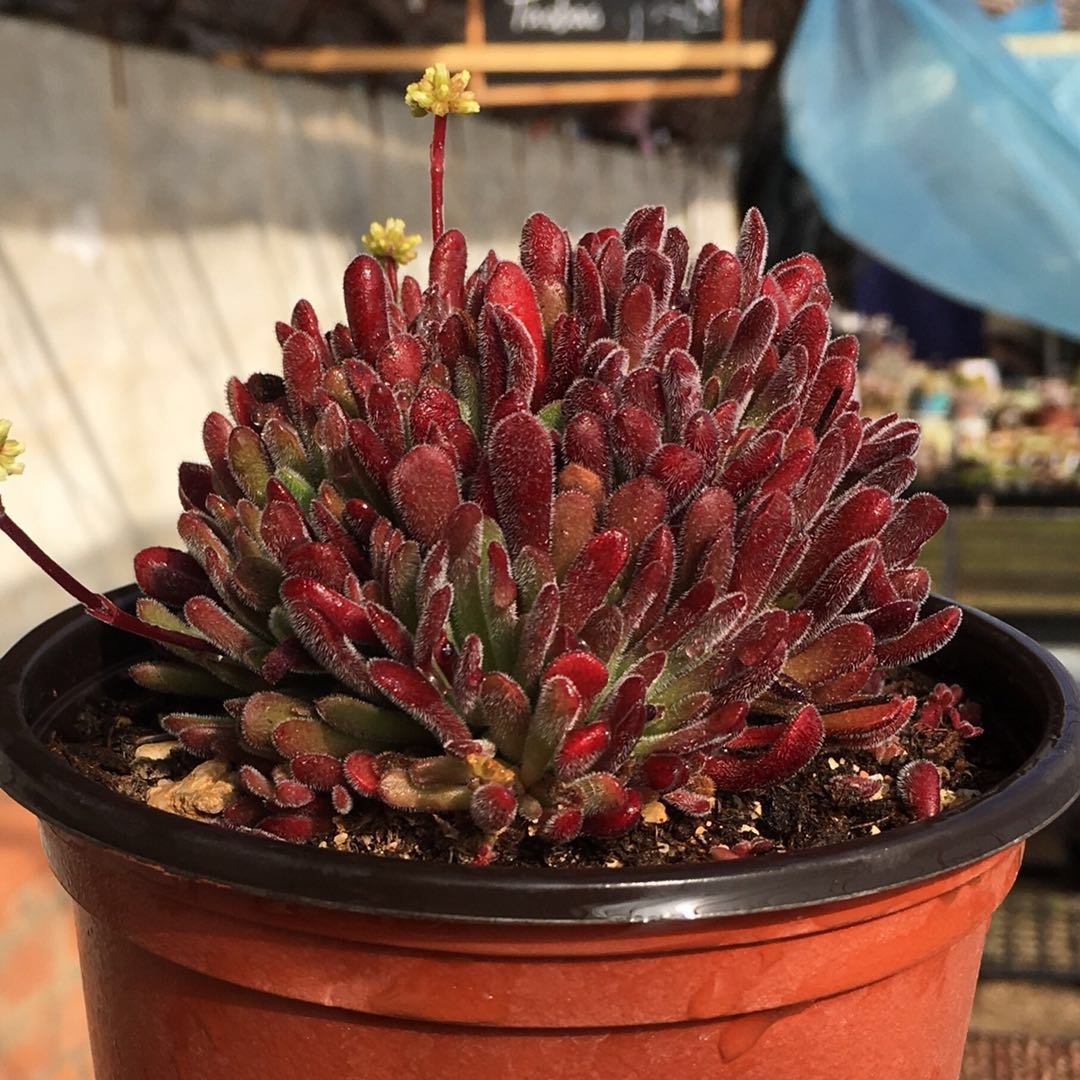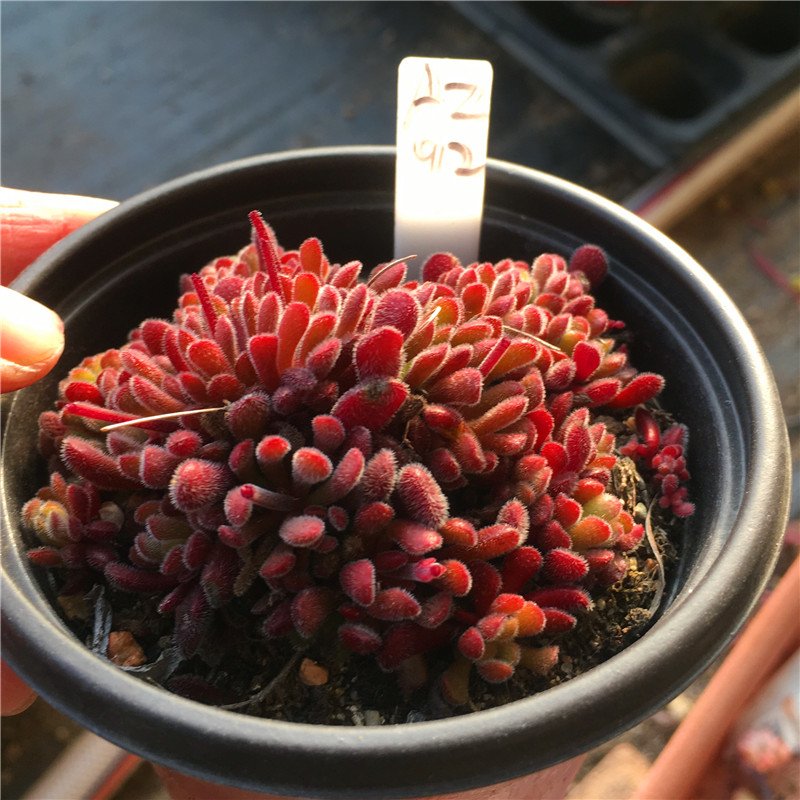
Crassula pubescens ssp. pubescens thrives when you meet its basic care needs. You should give this plant bright light, water only when the soil dries out, and use a well-draining mix. Many people wonder how to grow crassula at home. You can keep this plant healthy indoors or outdoors if you follow simple care steps. Crassula pubescens does not need much attention, so even beginners can succeed.
Key Takeaways
- Put your Crassula in bright light for four to six hours each day. Do not let it sit in strong midday sun. This helps stop the leaves from burning.
- Water the plant well only when the soil is fully dry. Use the soak and dry method to keep the roots healthy. This also helps you not to overwater.
- Use soil that drains well and has mineral grit. Pick a pot with holes at the bottom. This stops root rot and helps the plant grow strong.
- Keep your plant in temperatures between 60°F and 75°F. Make sure air moves around the plant. This helps stop bugs and sickness.
- Use a little fertilizer in spring and summer. Make sure it is diluted and made for succulents. Cut off dead leaves and look for pests like mealybugs often.
Light for Crassula

Sunlight Needs
Your crassula needs plenty of light to grow strong and healthy. Place your plant where it can get at least four to six hours of bright light each day. Outdoors, you can keep it in a spot with morning sun and afternoon shade. This plant enjoys full sun, but too much direct sunlight in the middle of the day can cause problems. If you grow your plant outside, choose a place with some protection from harsh midday rays. Indoors, a south or east-facing window works well.
Indoor Light Tips
If you keep your plant inside, make sure it gets enough light. A bright window is best. You can also use a grow light if your home does not have much natural sunlight. Turn your plant every week so all sides get light. Good air movement helps your plant stay healthy. Here are some tips for indoor care:
- Place your plant near a window with lots of light.
- Use a sheer curtain to soften strong sunlight.
- Move your plant closer to the window in winter.
Note: If your plant looks stretched or pale, it may need more light.
Preventing Sunburn
Too much direct sun can burn your plant’s leaves. You may see brown or white spots if this happens. To prevent sunburn, avoid placing your plant in strong afternoon sun, especially during hot months. Give your plant some shade during the hottest part of the day. If you move your plant outdoors, do it slowly so it can adjust to the brighter light.
Watering Care
Soak and Dry Method
You need to use the soak and dry method for Crassula pubescens ssp. pubescens. This method helps you avoid common watering mistakes. Start by watering the soil deeply until water drains out from the bottom of the pot. Let the soil dry out completely before you water again. This cycle mimics the natural environment of the plant. The roots get enough moisture, but they do not sit in wet soil.
Tip: Always check the top two inches of soil with your finger. If it feels dry, you can water your plant.
Watering Frequency
The right watering schedule depends on the season and your home’s conditions. During the growing season (spring and summer), you should water every 7 to 14 days. In the winter, the plant needs less water. You can wait 2 to 3 weeks between waterings. If you keep your plant outside, rain and temperature changes may affect how often you need to water.
Here is a simple table to help you remember:
| Season | Watering Frequency |
|---|---|
| Spring/Summer | Every 7–14 days |
| Fall/Winter | Every 2–3 weeks |
If you see the leaves start to wrinkle or look dull, your plant may need water. If the leaves feel soft and mushy, you may have watered too much.
Avoiding Overwatering
Overwatering is the most common mistake in plant care for succulents. Too much water can cause root rot and fungal problems. Always let the soil dry out before you water again. Make sure your pot has drainage holes. Remove any water that collects in the saucer under the pot.
Note: Crassula pubescens ssp. pubescens can handle short periods of drought better than sitting in soggy soil.
If you notice yellowing leaves or a bad smell from the soil, stop watering and let the plant dry out. Good plant care means watching your plant for signs of stress and adjusting your routine as needed. With the right watering habits, your plant will stay healthy and strong.
Soil and Potting for Crassula pubescens ssp. pubescens

Best Soil Mix
You want your crassula pubescens ssp. pubescens to grow strong roots. The right soil mix makes a big difference. Choose a cactus or succulent mix from the store, or make your own at home. The best soil contains 50% to 70% mineral grit. You can use coarse sand, pumice, or perlite. These materials help water drain quickly and keep the roots healthy.
- Use a commercial cactus or succulent mix.
- Add extra pumice, perlite, or coarse sand for better drainage.
- Avoid regular garden soil, which holds too much water.
Tip: Well-draining soil keeps your plant safe from root rot.
Pot Choice
The pot you pick matters for your crassula pubescens ssp. pubescens. Always use a pot with drainage holes. These holes let extra water escape, so your plant does not sit in soggy soil. Clay or terracotta pots work well because they let the soil dry out faster. Plastic pots are fine, but you must check that water does not collect at the bottom.
Here is a quick guide to help you choose:
| Pot Material | Dries Quickly | Has Drainage Holes | Good for Succulents? |
|---|---|---|---|
| Terracotta | ✅ | ✅ | ✅ |
| Plastic | ❌/✅ | ✅ | ✅ |
| Ceramic | ❌/✅ | ✅ | ✅ |
Note: Never use a pot without drainage holes for this plant.
Repotting Tips
You should repot your crassula pubescens ssp. pubescens every two to three years. Repotting gives your plant fresh soil and more space to grow. Pick a pot that is just a little bigger than the old one. Gently remove the plant from its old pot. Shake off the old soil and check the roots. Trim away any dead or mushy roots. Place the plant in the new pot with fresh, well-draining soil. Wait a few days before watering to let the roots settle.
- Repot in spring or early summer.
- Use clean tools to avoid spreading disease.
- Handle the plant gently to protect the roots.
A healthy pot and soil setup helps your crassula pubescens ssp. pubescens thrive for years.
Temperature & Humidity Plant Care
Ideal Range
You want your Crassula pubescens ssp. pubescens to stay healthy, so keep it in moderate temperatures. This plant grows best between 60°F and 75°F (16°C to 24°C). It can handle cooler nights, but you should protect it from frost. If the temperature drops below 50°F (10°C), move your plant indoors or to a warmer spot. High humidity is not good for this plant. Dry air helps prevent fungal problems and keeps the leaves firm.
Tip: Place your plant in a cool, bright room during hot summer days. Avoid areas with sudden temperature changes.
Ventilation
Good airflow is important for plant care. You should place your plant in a spot with gentle air movement. Open a window or use a small fan if the room feels stuffy. Proper ventilation helps the soil dry out and keeps pests away. If you grow your plant outdoors, choose a place with a light breeze. Avoid crowded shelves or corners where air cannot move.
- Place your plant near a window that opens.
- Use a fan on low speed if needed.
- Do not crowd your plant with other pots.
Dormancy Care
Crassula pubescens ssp. pubescens rests during winter. The plant slows its growth and needs less water. You must adjust your plant care routine for this season. Water only every 2-3 weeks, and let the soil dry out almost completely before watering again. Cooler temperatures down to 50°F (10°C) are safe, but do not let it get colder than 41°F (5°C).
Here is a helpful table for seasonal watering:
| Season | Watering Frequency | Soil Moisture Level |
|---|---|---|
| Spring/Summer | Every 7–10 days | Top inch of soil dry |
| Autumn | Every 10–14 days | Top 2 inches of soil dry |
| Winter | Every 2–3 weeks | Soil almost completely dry |
Note: During dormancy, less water keeps your plant safe from root rot. Always check the soil before you water.
With the right temperature, low humidity, and careful watering, your plant will thrive all year. Adjust your plant care as the seasons change to keep your Crassula pubescens ssp. pubescens strong and healthy.
Fertilizing & Cultivate Crassula pubescens
Fertilizer Type
You want your crassula pubescens ssp. pubescens to grow strong and healthy. Choose a balanced fertilizer made for succulents or cacti. Look for a product with equal parts nitrogen, phosphorus, and potassium, such as a 10-10-10 or 20-20-20 formula. Always dilute the fertilizer to half or even a quarter of the recommended strength. This helps prevent root burn and keeps your plant safe.
Tip: Liquid fertilizers work best because you can mix them with water and spread them evenly in the soil.
Feeding Schedule
Feed your plant only during its active growing season, which is spring and summer. You do not need to fertilize in fall or winter when the plant rests. Apply the diluted fertilizer once every three months. Too much feeding can harm your succulent, so less is better. If you see new growth and healthy leaves, your plant gets enough nutrients.
Here is a simple feeding schedule:
| Season | Fertilizer Application |
|---|---|
| Spring | Once (diluted) |
| Summer | Once (diluted) |
| Fall/Winter | None |
Note: Always water your plant before you fertilize. This protects the roots from damage.
Pruning & Propagation
You can keep your plant neat by pruning away dead or damaged leaves. Use clean, sharp scissors or pruning shears. Remove any stems that look weak or stretched. Pruning helps your plant focus energy on healthy growth.
If you want to cultivate crassula pubescens, try propagation. This succulent makes it easy. Take a healthy leaf or stem cutting and let it dry for a day. Place the cutting on top of well-draining soil. Mist the soil lightly until you see roots. Soon, you will have a new plant to enjoy or share.
Pruning and propagation help you shape your plant and grow your collection.
Common Plant Care Problems
Pests & Diseases
You may notice that Crassula pubescens ssp. pubescens usually stays healthy, but pests can still appear. The most common pest is mealybugs. These tiny insects look like white cotton on your plant. They hide in leaf joints and feed on the sap. You should check your plant often, especially if you see sticky spots or fuzzy leaves. Most home growers do not face many diseases with this plant. If you spot mealybugs, remove them with a cotton swab dipped in rubbing alcohol. Keep your plant in a well-ventilated area to prevent pest problems.
- Mealybugs are the main pest.
- Diseases rarely affect this plant.
- Regular checks help keep your plant healthy.
Tip: Isolate new plants for a few weeks before placing them near your other succulents.
Leaf Issues
You might see changes in your plant’s leaves if something is wrong. Leaf curling and yellowing often mean your plant needs more nutrients or you watered too much. Nitrogen deficiency causes leaves to curl, turn yellow, and stop growing well. Potassium deficiency makes leaf edges brown and curled. Overwatering leads to curling, yellow leaves, and mushy stems. Both nutrient problems and too much water cause leaf curl and color changes, but overwatering also makes stems soft and roots rot. Watch your plant’s leaves to catch problems early and protect plant health.
- Nitrogen deficiency: curled, yellow leaves, stunted growth.
- Potassium deficiency: curled leaves with brown edges.
- Overwatering: curled, yellow leaves, mushy stems, root rot.
Growth Troubleshooting
Sometimes your plant may look stunted or leggy. This often happens when it does not get enough light or the soil does not drain well. Place your plant near a bright window, such as south or west-facing, to give it enough sunlight. Use a grow light if your home is dark, especially in winter. Repot your plant in a mix with peat moss, perlite, and orchid bark for better drainage. Prune long, thin stems to help your plant grow fuller. Check the soil before watering and keep a regular schedule. Keep humidity between 50-70% and temperatures from 68°F to 86°F (20°C to 30°C). Feed your plant with a balanced fertilizer every 4-6 weeks during the growing season. Avoid drafty spots and sudden temperature changes. Adjust your care as the seasons change to support strong growth.
Note: Healthy care routines help your plant stay compact and vibrant.
Safety and Toxicity
Pets & Kids
You want to keep your home safe for everyone, including pets and children. Crassula pubescens ssp. pubescens is considered mildly toxic if eaten. If a cat, dog, or child chews on the leaves, they may feel sick. Symptoms can include vomiting, diarrhea, or an upset stomach. You should place your plant out of reach. High shelves or hanging planters work well. Always teach children not to touch or taste houseplants.
Note: If you think your pet or child has eaten part of the plant, call your veterinarian or doctor right away.
Here is a quick reference table:
| Who is at Risk? | Possible Symptoms | What to Do |
|---|---|---|
| Cats & Dogs | Vomiting, diarrhea | Contact your vet |
| Children | Upset stomach, nausea | Call your doctor |
Handling Tips
You should handle your plant with care. The leaves can break easily if you squeeze them. Wash your hands after touching the plant, especially before eating or touching your face. Some people have sensitive skin and may get mild irritation from the sap. Use gloves if you have allergies or cuts on your hands.
- Use clean tools when pruning or repotting.
- Avoid rubbing your eyes after handling the plant.
- Keep the area around your plant tidy to prevent accidents.
Tip: Always supervise young children and pets when they are near your plant. Safe handling keeps everyone healthy and happy.
Here is a quick-reference checklist to help your crassula thrive:
- Give bright, indirect sunlight or up to six hours of direct sun daily.
- Use well-draining, gritty soil to prevent root rot.
- Water deeply but let the soil dry out between waterings.
- Fertilize sparingly during spring and summer.
- Prune and check for pests often.
- Protect your plant from frost and extreme heat.
Paying attention to these steps helps your plant stay healthy. Bookmark or share this guide for easy access anytime.
FAQ
How often should you repot Crassula pubescens ssp. pubescens?
You should repot every 2–3 years. Choose a pot just a bit larger than the old one. Fresh soil helps your plant grow better. Spring is the best time for repotting.
Why are your Crassula’s leaves turning yellow?
Yellow leaves often mean you watered too much. Let the soil dry out before you water again. Check for root rot. Remove mushy roots and use well-draining soil.
Can you grow Crassula pubescens ssp. pubescens from a single leaf?
Yes! Take a healthy leaf, let it dry for a day, then place it on gritty soil. Mist lightly until roots form. Soon, you will see a new plant start to grow.
What should you do if your plant gets sunburned?
Move your plant to a spot with bright, indirect light. Trim away damaged leaves. Water as usual. Your plant will recover with gentle care and protection from harsh sunlight.